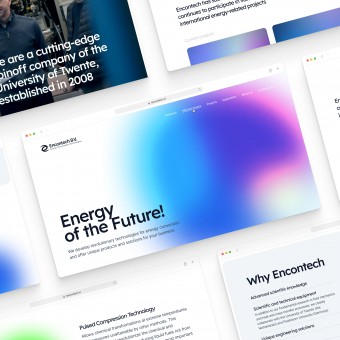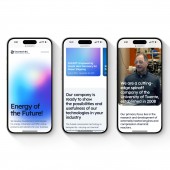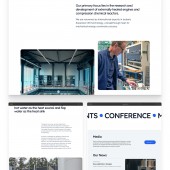
| THE AWARD |
| CATEGORIES |
| REGISTRATION |
| SUBMIT YOUR WORK |
| ENTRY INSTRUCTIONS |
| TERMS & CONDITIONS |
| PUBLICATIONS |
| DATES & FEES |
| METHODOLOGY |
| CONTACT |
| WINNERS |
| PRESS ROOM |
| GET INVOLVED |
| DESIGN PRIZE |
| DESIGN STORE |
| THE AWARD | JURY | CATEGORIES | REGISTRATION | PRESS | WINNERS | PUBLICATIONS | ENTRY INSTRUCTIONS |
Encontech B.v. Website by Dmitrii Lagunov |
Home > Winners > Design #155404 >Interview |
 |
|
FS: What is the main principle, idea and inspiration behind your design?
DL: The main principle and idea behind my design is to prioritize simplicity and usability in every aspect of the product. As a digital designer, I believe that design should be the primary tool of user interaction at each point of contact, ensuring a seamless and intuitive user experience. This focus on user-centric design helps to maintain the integrity of brand perception, increases user engagement, and stimulates growth. My inspiration comes from a commitment to make the world easier to use through design, creating products that are accessible and user-friendly for everyone. By prioritizing simplicity and usability, I strive to create designs that not only look beautiful but also function flawlessly, providing value to users and businesses alike.
FS: What has been your main focus in designing this work? Especially what did you want to achieve?
DL: The primary focus in designing this work was to effectively communicate the advantages of adopting new energy-saving technologies in an easily understandable manner. The animation was designed to visually represent the process of energy transformation, highlighting the efficiency and sustainability of these technologies. In terms of user interface design, simplicity, and clarity were prioritized to ensure a seamless and intuitive user experience. The central metaphor utilized in the design is the transformation of energy from one form to another, emphasizing the potential for positive change through the adoption of these technologies. Overall, the goal was to create an engaging and informative design that encourages users to consider the benefits of energy-saving technologies and inspires them to take action toward sustainability.
FS: What are your future plans for this award winning design?
DL: Moving forward, my vision for this award-winning design with Encontech entails an ongoing process of refinement and expansion guided by user feedback and emerging requirements. Recently, we engaged in discussions with a client regarding incorporating additional website sections and integrating pertinent content to enhance the user experience further.
FS: How long did it take you to design this particular concept?
DL: It took a couple of months to design this particular concept from start to finish. Throughout this time, we conducted extensive research, held brainstorming sessions, and created and refined numerous design iterations. Although it was a lengthy and time-consuming process, each phase was crucial in shaping the final design. Our dedication and attention to detail throughout the design journey ultimately resulted in a product that met and exceeded expectations.
FS: Why did you design this particular concept? Was this design commissioned or did you decide to pursuit an inspiration?
DL: This concept was developed as part of a commercial project. After presenting multiple options to the client, we agreed upon this solution.
FS: Is your design being produced or used by another company, or do you plan to sell or lease the production rights or do you intent to produce your work yourself?
DL: Yes, it is a fully functioning website. The client is actively using it in communications with their potential clients and current partners.
FS: What made you design this particular type of work?
DL: Oh, thank you. That's a very interesting question. As a designer, you come into contact with many industries and technologies in your daily life. You know, I've always been interested in energy savings and making a system more efficient. Many scientific and engineering teams worldwide are actively working on the problem of accumulating excess heat from the work of mechanisms and units. Our client has successful developments and applies them in the laboratory and specific cases.
FS: Where there any other designs and/or designers that helped the influence the design of your work?
DL: During the design process, I conducted extensive research and analysis of various websites related to sustainability and environmental responsibility. I paid close attention to their approaches to user experience, visual design, and functionality. The design was heavily influenced by the principles of human-centered design and design thinking, which are widely endorsed by designers such as Don Norman, co-founder of the Nielsen Norman Group. The primary objective was to create an intuitive and user-friendly interface that prioritizes the needs and experiences of the users. Additionally, I took inspiration from renowned designers in the field, including Dieter Rams, whose work has significantly influenced my design principles and thinking.
FS: Who is the target customer for his design?
DL: These are different companies in the working cycle, and their temperatures are different. Here are a few industries where the application of such technologies can be very cost-effective: ship engines, water distillation, geothermal energy, data centers, and chemical or metallurgical production.
FS: What sets this design apart from other similar or resembling concepts?
DL: To explain in simple terms the benefits of using new energy-saving technologies. The transformation of energy is reflected in the animation.
FS: How did you come up with the name for this design? What does it mean?
DL: It's the client's company name, which is made up of the words energy conversation technology.
FS: Which design tools did you use when you were working on this project?
DL: We used the following tools: Trello to manage the development workflow, Miro for the customer journey map, design in Figma, illustrations and icons in Illustrator, and layout of the event analytics structure in Google Sheets.
FS: What is the most unique aspect of your design?
DL: I built the whole design around the metaphor of energy transformation. Simplicity and functionality - pure energy.
FS: Who did you collaborate with for this design? Did you work with people with technical / specialized skills?
DL: The project focused on the following areas of research: stakeholder interviews, competitor analysis, focus groups, etc. Of course, implementing the design into a working website required the work of a web developer.
FS: What is the role of technology in this particular design?
DL: Modern web browsers evolve regularly and become more technologically advanced, with support for new features. This makes it possible to create more complex animations on websites and thus increase user engagement. More convenient frameworks appear every year, and development becomes possible in a shorter time and with greater productivity.
FS: Is your design influenced by data or analytical research in any way? What kind of research did you conduct for making this design?
DL: Yes, the design was influenced by data and analytical research. To ensure that the design met users' needs and expectations, I conducted extensive research and analysis of various websites related to sustainability and environmental responsibility. The research process included stakeholder interviews, competitor analysis, focus groups, and other methods to gather insights and feedback. This data-driven approach helped inform the design decisions and ensure that the final product was user-centric and effectively achieved its goals.
FS: What are some of the challenges you faced during the design/realization of your concept?
DL: In designing and realizing this concept, one of the challenges I faced was balancing functionality with simplicity, ensuring that the design remained intuitive and user-friendly while providing comprehensive features.
FS: How did you decide to submit your design to an international design competition?
DL: I was confident that my design possessed the caliber to make a mark and garner recognition at an international level. Viewing it as a chance to gain exposure, glean insightful feedback, and spotlight my talents and ingenuity to a broader community of design fans, I decided to submit it to an international design competition. My goal is to share my work with a diverse audience and spark conversations about the pivotal role of design in achieving business objectives and fostering positive societal impacts.
FS: What did you learn or how did you improve yourself during the designing of this work?
DL: This project taught me the significance of thinking beyond conventional solutions. I discovered the transformative power of incorporating user feedback and iterative processes into my design approach. It reinforced my belief that adhering to the design process invariably leads to uncovering the most optimal solution, regardless of its classification. Through this experience, I've evolved as a designer, gaining a deeper appreciation for user-centered design principles and expanding my creative repertoire.
FS: Any other things you would like to cover that have not been covered in these questions?
DL: I'd like to underscore the significance of ongoing learning and keeping abreast of the industry's newest trends and technologies. Maintaining a growth mindset and actively pursuing avenues for professional advancement is key to staying relevant and innovative as a designer. Moreover, I firmly advocate for the ethos that design should consistently aim to address tangible challenges, foster positive change, and enhance societal well-being.
FS: Thank you for providing us with this opportunity to interview you.
A' Design Award and Competitions grants rights to press members and bloggers to use parts of this interview. This interview is provided as it is; DesignPRWire and A' Design Award and Competitions cannot be held responsible for the answers given by participating designers.
| SOCIAL |
| + Add to Likes / Favorites | Send to My Email | Comment | View Press-Release |





